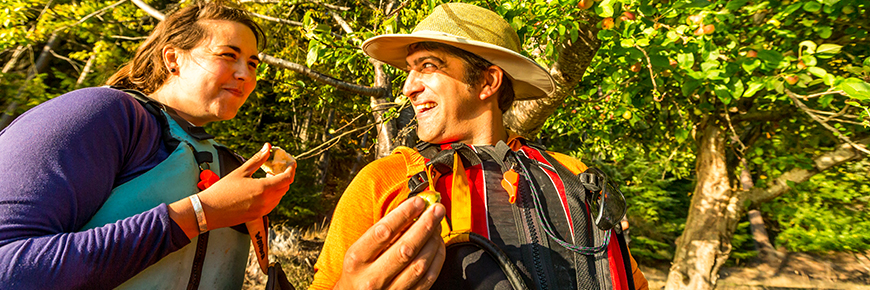
Fruit picking
Gulf Islands National Park Reserve
What You Need to Know | Top 6 Orchards to Visit | Pre-Trip Checklist | Safety Tips
Have a taste of history—pick a basket of apples, pears, cherries, plums, quince, or nuts from one of 17 orchards located in the Gulf Islands National Park Reserve.
What you need to know
There are several conditions that apply when picking fruit from orchards in the park reserve:
- Items to be harvested are limited to apples, pears, cherries, plums, quince, and nuts, including walnuts;
- Harvesting is restricted to fruits produced by the trees, and does not include other items of the tree, such as cuttings, leaves or grafts;
- Harvesting must be done by handpicking and without the use of ladders, however picking poles may be used;
- Removal of fruits should not lead to further damage of the trees (e.g., removal of bark or branches)
- Fruit trees are not to be climbed and must be treated gently and with respect;
- The amount harvested by an individual must not exceed six pieces per fruit type at any one time so that other visitors can also enjoy this experience; and
- Fruit is to be picked when ripe, and when it has fallen to the ground or can be removed easily from the branch without also pulling off portions of the branches or stems.
Top 6 Orchards to visit
Gulf Islands National Park Reserve has 17 orchards which visitors can explore and enjoy. Here are the top six:
- Roesland Orchard, North Pender Island – Apple, pear, cherry, plum, and walnut trees were planted in the 1910s by Scottish settler Robert Roe Sr.
- Shingle Bay Orchard, North Pender Island – Apple orchard with varieties Red Delicious, Golden Delicious and Spartan.
- Palau Orchard (Princess Bay), Portland Island – At least seven heritage apple varieties remain today, including Newton Wonder and Lemon Pippen.
- James Bay Orchard, Prevost Island – The largest orchard in the park reserve, with apple and walnut trees. There are at least three known varieties of apples there including Antonovka Apples that originated in Russia
- Mahoi Orchard, Russell Island – Apple and cherry orchard which served as a home fruit garden for the Hawaiian settlers William Haumea and the Fisher family.
- Narvaez Bay Orchard, Saturna Island – The Georgeson family planted this orchard in the 1920s, and it has at least six apple varieties.
Pre-trip checklist
When preparing for your fruit-picking trip, ensure you have all the appropriate equipment and dress for the season. Here are some items to consider packing:
- Plenty of water – There is no freshwater available at any of the orchard sites.
- Garbage bags – Garbage facilities are only available at car campgrounds.
- Warm clothes – Wool and quick dry polypropylene outfits are good for the climate.
- Rain gear
- Sun screen, sunglasses and hat
- Camera
- First aid kit
- Fruit collecting basket, bucket or bag
- Picking poles (optional)
Safety tips
When visiting Gulf Islands National Park Reserve, you are in an area where rescue services and medical assistance may take time to reach you in case of an emergency. Ensure that you have the level of training, experience and equipment necessary to take responsibility for your safety.
Some safety tips include:
- Inspect the orchard grounds for potential tripping hazards and watch for loose tree branches overhead, especially after a wind storm.
- Do not collect or consume fruit that appears rotten or damaged.
- Handle food safely.
Obtain emergency contact information and learn more about Visitor Safety at Gulf Islands National Park Reserve.
The maximum group size is 15 for all day use areas. Larger groups and anyone planning a formal event (picnic, reunion, wedding, etc.) need to obtain a permit.
Learn more about other national park regulations.
Make sure to check the Important Bulletins for closures and public safety alerts before you leave home.
"Leave No Trace™" principles promote and inspire responsible outdoor recreation and stewardship. Learn more about Leave no Trace™ in Gulf Islands National Park Reserve.
The most important tip of all is to have fun and enjoying eating the wonderful heritage fruit of Gulf Islands National Park Reserve!
- Date modified :